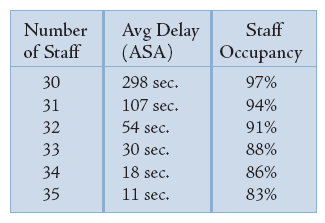 |
Reducing Staff May Cost You Money
By Penny Reynolds, The Call Center School |
Many businesses have felt the effect of a slowed economy over the past few years. All departments, including the call center, have been asked to tighten their belts and make the most of resources.
Because about 75 percent of call center’s operating costs are related to staffing, that is generally the first place the call center manager might look to reduce costs. It is all too common to think of layoffs and reduction in staff as a way to respond to the call from senior management to tighten belts. But before you write up the pink slips, make sure you understand the implications of staff reductions.
Let’s assume that you’re a fairly small call center with fewer than 50 agent seats. (If you’re a larger center, you can view these numbers as representative of a specialized agent group within the bigger call center structure.) Most days, you’re meeting your service goal of 30 seconds. The snapshot below indicates the staffing picture with varying numbers of staff during an hour in which you’re getting 350 calls.

Staffing with 33 “bodies in chairs” would enable you to meet the service goal fairly consistently. A strategy of decreasing staff numbers to reduce costs would impact service directly. The loss of one person would worsen delays from 30 seconds to 54 seconds. Eliminating another person would double the wait 107 seconds, and reducing staffing levels by three agents would result in an average delay of 298 seconds. Those callers accustomed to waiting for only half a minute in queue would now be waiting nearly five minutes!
Unfortunately, service isn’t the only thing that suffers. With 33 staff members in place to handle the call workload, agent occupancy (the measure of how busy staff are during the period of time they’re logged in and available) is in an acceptable range at 88 percent. Taking one body away raises occupancy levels to 91 percent; taking two away results in 94 percent occupancy; and taking three staff members away means staff would be busy 97 percent of the time during the hour. In other words, there would be a total of only 3 percent of the hour (108 seconds) of “breathing room” between calls. Such a high level of occupancy can’t be maintained for long. The likely result will be longer handle times, longer periods spent in after-call work to “catch their breath,” burnout and, inevitably, turnover.
There’s another downside to consider from a cost perspective. The idea was to save money by eliminating staff. Assuming a wage rate of $20 per hour, then eliminating three staff members, would result in a savings of $60 for that hour.
However, if your center is paying the phone bill by providing a toll-free service for callers, the reduction in staff might be outweighed by the increased telephone costs associated with the longer delay times. In this example, with 33 staff members in place, the average delay is 30 seconds per call. Multiply that by 350 calls per hour and that’s 10,500 seconds (or 175 minutes) of delay. If we apply a fully loaded telephone cost per minute to that usage of $.06 per minute, that’s $10.50 for the queue time.
If we reduce the numbers to 30 staff, remember our average delay increases to 298 seconds of delay per call. Multiply that by 350 calls and that’s 1,738 minutes of delay, priced at $.06 for a total of $104.30 for the queue time that hour. In other words, by eliminating three staff members to save money, we’ve just increased our telephone bill by $93.80 for that hour! And this doesn’t even take into account the likelihood that calls under these circumstances will more often fail to reach expected service levels.
The cost implications are even more dangerous in a revenue-producing center. If the value of a contact is $50, and agent salaries are $20 per hour, it is easy to see that putting another agent on the phone will pay for itself even if the agent answers only one call per hour that would otherwise have abandoned from the queue. Even if the value of the call is only $5, there is clearly a trade-off in determining the staffing level that will produce the highest net bottom line. The return on appropriate staffing must be argued against budget constraints.
So, from three different perspectives: that of the customer (service delays), the agent (higher occupancy), and senior management (higher telephone costs and abandoned calls), it’s easy to see that a simple staff reduction may not save you any money. In fact, it may cost you much more in terms of poor service, productivity, morale and just the opposite direction on your bottom line than what you intended.
Penny Reynolds is a Founding Partner of The Call Center School, a Nashville, Tennessee-based consulting and education company. She is the author of several call center management books, including Call Center Staffing— The Complete, Practical Guide to Workforce Management. Contact her at penny. [email protected] or call 615-812-8410.
[
Return
To January 2005 Table Of Contents ] |